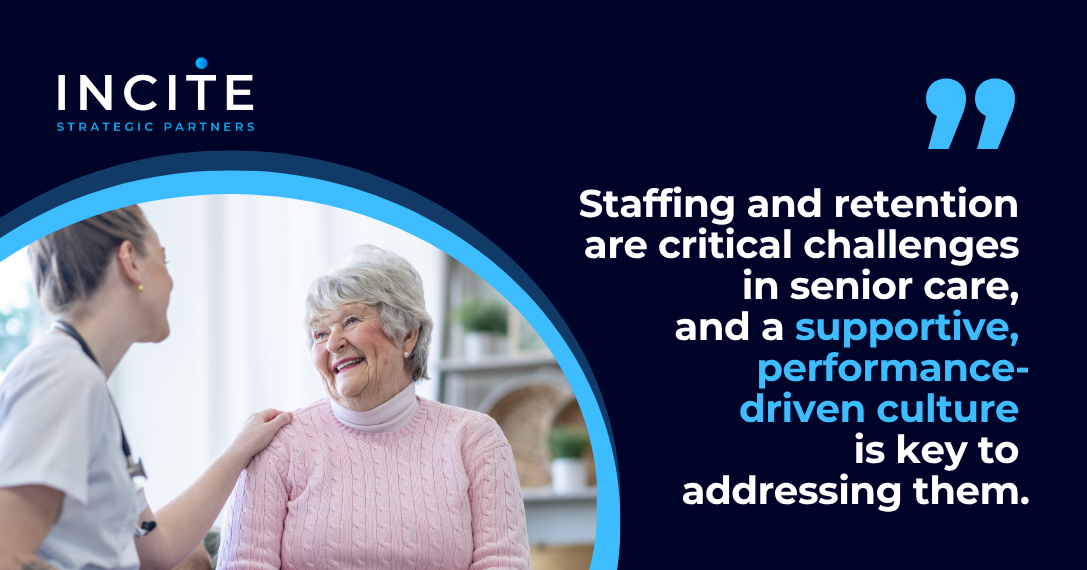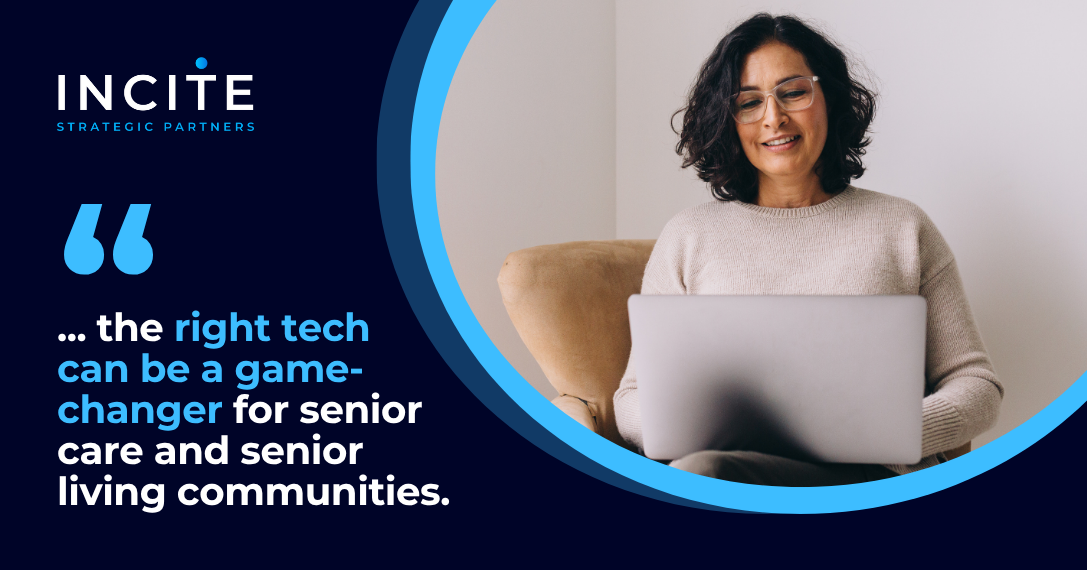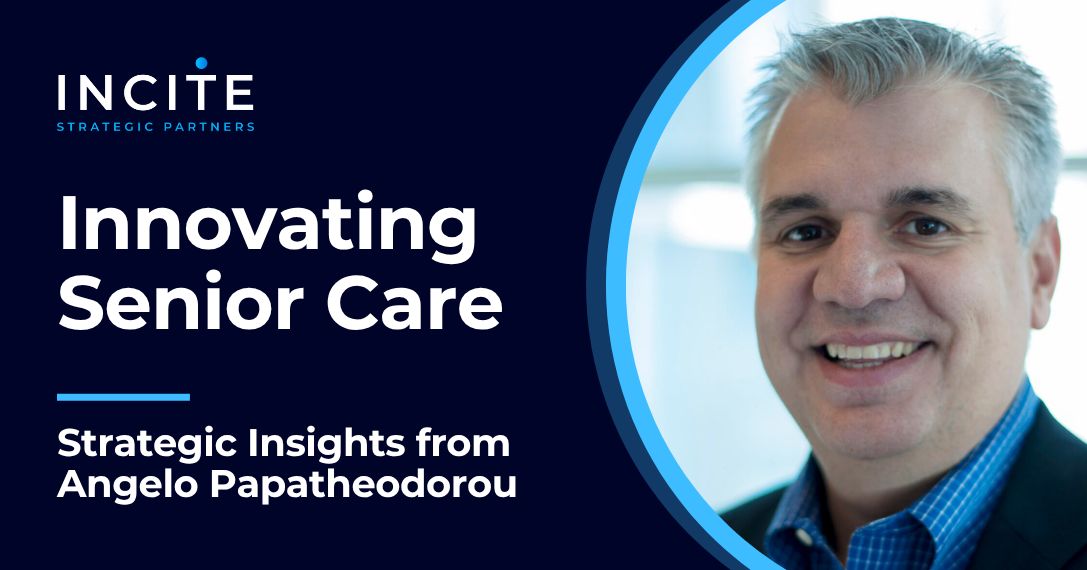Angelo Papatheodorou is a seasoned leader in the senior care industry, known for his decades-long tenure at PointClickCare and his role as an advisory board member at Incite Strategic Partners. With a career spanning 24 years in senior care tech and strategic operations, Angelo has a unique perspective on how innovation and operational excellence can transform senior living communities. In this interview, Angelo shares insights on scaling with quality, emerging industry trends, leveraging group purchasing, building strong teams, maintaining a results-driven yet compassionate culture, and the future of technology in senior care.
Q: Drawing from your experience at PointClickCare, what key strategies or operational practices can senior care communities implement to scale effectively while still maintaining high-quality resident care?
A: In my experience, scaling effectively starts with a strong foundation of processes and data. At PointClickCare, we learned that you can’t grow successfully without consistent operational practices and a way to measure outcomes at every step. For a senior care community, that means developing standard care protocols and quality benchmarks that every location or team follows. When you have clear, evidence-based care workflows, you ensure that as you expand or take on more residents, the quality of care remains consistently high.
It’s crucial to leverage technology to streamline administrative burdens – for example, using an electronic health record platform to centralize resident information and automate routine tasks. This frees up your staff’s time to focus on residents. We always said efficiency should never come at the expense of quality. So as you implement time-saving tools or expand services, also monitor key quality indicators (like resident satisfaction, re-hospitalization rates, falls, etc.) closely. If any metric starts to slip, take it as an early warning and adjust processes immediately.
I’ve seen organizations successfully scale by investing in staff training and leadership development too – a well-prepared team can uphold high standards even as the census grows. Finally, scaling “smart” means maintaining a resident-centered culture. Growth is not just about serving more people; it’s about serving people well. As we grew teams at PointClickCare, we doubled down on our mission and values. Similarly, senior care operators should continuously communicate the core mission of compassionate care to every new staff member and every new location. When everyone is aligned with that mission, you can grow in size without losing the heart and personal touch that defines great care.
Q: You’ve seen the senior care industry evolve rapidly. What major trends do you anticipate in the next few years, and how can communities position themselves to adapt and thrive?
A: The pace of change in senior care is unprecedented right now. One major trend is the demographic tidal wave we’re facing. The population of seniors is growing dramatically – by 2040, the U.S. will have about 81 million people over 65, up from 54 million in 2019. That huge increase in elders comes with higher acuity levels and more complex care needs in our communities. At the same time, we’re dealing with a workforce shortage – about 59% of nursing homes are facing serious staffing shortages.
Fewer caregivers for more seniors means communities must find new ways to do more with less. I anticipate senior care providers will need to be extremely innovative in workforce solutions – from improving retention, so you’re not constantly training new staff, to leveraging technology and process improvements to augment staff efficiency.
Another trend is the rise of technology and data-driven care. The pandemic accelerated the adoption of telehealth and digital tools across senior care, and there’s no going back. Residents and their families now expect tech-enabled services – like virtual physician visits, digital health monitoring, and instant communication. Communities that embrace these tools will have an edge.
We’re also moving toward value-based care models in long term care. Regulators and payers are looking for better outcomes, not just services provided. I tell providers to prepare for more emphasis on outcomes like reduced hospital readmissions, successful rehab stays, and preventive care. Those who invest in care coordination and strong data analytics to track outcomes will thrive in this environment.
Financial and operational pressures are a reality too – margins are thin (the median operating margin for U.S. skilled nursing was around 0.6% recently) and we’ve seen about 450 nursing facilities close as of early 2023, putting 28% of SNF residents at risk of displacement. While that’s sobering, it highlights that efficiency and smart management are going to be paramount. Senior living communities should position themselves by building resiliency:
- Diversify services. For instance, adding home care programs or adult day services to complement residence care.
- Forge partnerships with hospitals or health systems to become a preferred post-acute partner.
- Have contingency plans for economic swings.
Lastly, I see resident expectations evolving. The next generation of seniors and their adult children will demand more personalized experiences – better dining options, wellness programs, and a say in their daily schedules. They’re also more tech-savvy. Communities that create a vibrant, hospitality-driven environment while still providing top-notch healthcare will stand out.
Q: GPOs, like Incite Strategic Partners, can play a significant role in helping senior care organizations optimize their purchasing. What advice would you give communities on how to fully leverage a GPO partnership for cost savings and improved operations?
A: GPOs can be powerful allies, but it’s important to proactively engage them as strategic partners. Start by thoroughly exploring all the resources your GPO offers. Incite Strategic Partners, for instance, provides not only discounted contracts but also valuable e-procurement tools and analytics to help identify savings and standardize purchasing. By fully utilizing available contracts – particularly in major categories like food and medical supplies – communities can achieve savings of 4-5%, funds that can be reinvested directly into resident care or staff development.
Regular, open communication with your GPO account manager is key. Think of them as an extension of your procurement team – clearly share your goals and challenges so they can effectively advocate for your needs. Participating in GPO-hosted training sessions and community forums is another great way to learn industry best practices and uncover new opportunities.
Also, integrate your GPO partnership deeply into your internal processes. Provide staff with thorough training on the ordering systems, and encourage consistent use of contracted vendors. Schedule periodic reviews of spending data with your GPO to proactively identify new cost-saving opportunities and set actionable goals. By taking a strategic and collaborative approach to your GPO partnership, you can streamline operations, reduce costs, and enhance overall performance.
Q: Staffing and retention are constant challenges in senior care. How can leaders foster a supportive, performance-driven culture that encourages longevity, professional growth, and consistent resident-focused care?
A: Staffing and retention are critical challenges in senior care, and a supportive, performance driven culture is key to addressing them. Leaders need to create an environment where employees feel valued, heard, and part of something meaningful. In practical terms, that starts with open communication and recognition. Make sure frontline staff know their work truly matters. Celebrate the “wins” – not just business metrics but personal moments of excellence. For example, highlight when a nurse’s aide comforts a resident’s family or a dining team member crafts a special meal. When people see leaders notice and appreciate these efforts, it reinforces a culture of compassion and excellence.
Equally important is empowering your team and fostering trust. Involve staff in decision-making – whether improving a workflow or adjusting schedules – so they take ownership and pride in the results. A supportive culture means leaders act as coaches, not just bosses. Regular check-ins on well-being and idea-sharing, along with forums like staff councils or town halls for feedback, go a long way. When challenges arise, a supportive leader stands beside the team to solve problems. Focus on your people, and they will focus on your residents.
But culture alone may not be enough – leaders must also be proactive with smart staffing strategies. This is where technology can help. For example, Incite Workforce Solutions (IWS) gives you complete workforce visibility by showing all available talent, including internal staff, in one place. It helps create sustainable staffing by reducing reliance on temp labor, and offers customizable workforce analytics for smarter hiring and scheduling. Ultimately, pairing a supportive culture with modern workforce solutions like IWS fosters longevity, professional growth, and consistent, resident-focused care.

Q: With your track record of “never missing a quarter,” how can senior care operators embed a results-oriented mindset into their organizations without sacrificing empathy and the human element of care?
A: I chuckle at the “never missing a quarter” mention – it’s true, I’ve been very focused on hitting targets throughout my career. But I can honestly say the way we achieved consistent results was by putting people first, both customers and team members. In a senior care context, that means recognizing that the ultimate “result” is excellent resident outcomes. Financial sustainability and growth are critical results as well, but they flow naturally when you get the quality of care right. So to embed a results-oriented mindset, I advise operators to set balanced goals. Don’t just communicate census or revenue goals. Include goals for resident satisfaction, health outcomes, and staff satisfaction too. For example, track improvements in things like your 5-star quality rating or your family satisfaction survey scores alongside your financial KPIs. This sends the message that caring and performance are intertwined.
One practical approach is using a dashboard or scorecard that mixes hard metrics, like occupancy %, budget variance, length of stay, etc. with heart metrics, like number of resident testimonials or staff engagement scores. Review these in leadership meetings regularly. It trains everyone to think in terms of results and impact. Now, achieving those results still requires a disciplined approach: strong accountability at all levels, timely follow-up on action items, and a drive to continuously improve. That’s where the “never miss” mindset comes in – it’s about creating a culture where people take ownership of outcomes. If a goal is missed, the team asks “why and what can we do differently?” rather than making excuses. Leaders should model this by being transparent about organization performance and rallying the team to problem-solve when needed.
Q: Technology continues to shape senior care, from EHR platforms to telehealth solutions. What are the most promising tech opportunities that communities should consider adopting to enhance both business efficiency and resident outcomes?
A: I’m obviously a bit biased toward technology given my background, but I truly believe the right tech can be a game-changer for senior care and senior living communities. One foundational technology is a comprehensive EHR (Electronic Health Record) system. If a community hasn’t fully implemented one, that’s step one – it centralizes all resident information, care plans, medication records, etc., reducing errors and ensuring continuity of care.
But beyond just having an EHR, the opportunity is in harnessing the data. Modern senior care EHR platforms now offer analytics and decision support. They can flag risk factors, like a resident whose condition is deteriorating, and help prioritize care. Embracing these analytics can directly improve outcomes – you catch issues early and can intervene before a small health concern becomes a hospital transfer.
Telehealth and virtual care are another huge opportunity. We saw during COVID-19 how effective telehealth could be in senior living settings, and it’s here to stay. Implementing a telehealth program means your residents can get timely medical evaluation without the disruption of leaving home for every specialist visit. It also eases the burden on your staff; for instance, after-hours telemedicine coverage can handle issues that would otherwise send a resident to the ER or require an on-call nurse to come in.
We also have emerging tech like IoT (Internet of Things) devices and wearables. These can monitor residents’ vital signs, movement, or environment in real time. Imagine sensors that alert staff if a resident may have fallen or smart devices that track sleep patterns and nutrition. Early adopters are using things like wearable pendants or room sensors that help prevent falls or detect them immediately, which can drastically improve response times and outcomes. Similarly, automated medication dispensing systems can ensure the right meds at the right times and flag any misses. All these reduce human error and keep residents safer.
Another promising area is family and resident engagement technology. Many communities are adopting apps or portals where families can check in on their loved one’s daily activities, health updates, or even send messages. This not only increases family satisfaction (they feel more connected and informed) but can streamline communication for staff (fewer phone calls to return). Some platforms also allow residents to request services or sign up for activities via tablets or kiosks – empowering them and creating operational efficiency for staff organizing events or maintenance requests.
Lastly, I have to mention AI and predictive analytics as the next frontier. We’re beginning to see AI tools that can comb through data and predict who is at risk for things like hospitalization, pressure ulcers, or even depression, based on subtle changes in daily living data. These tools can guide staff to intervene earlier. It’s still an emerging field, but very promising for improving care outcomes. On the business side, AI can help with things like staffing forecasts (predicting how many staff you’ll need based on resident acuity trends) or even optimizing supply ordering.
My advice is for communities to identify their pain points or goals first, then find tech that addresses those. It might be reducing readmissions, improving staff documentation efficiency, or enhancing resident engagement. There’s likely a technology solution for each of those now. Start with one or two high-impact technologies – implement them well with proper training and support for staff – and once you see the benefits, you can build on that. The end game is tech that doesn’t replace the human touch but amplifies it: making operations smoother so caregivers have more time with residents, and giving residents tools that help them live healthier and happier lives.

Q: You mentor tech executives, but you’ve also consulted widely in long-term health care. What’s one piece of advice you find yourself sharing most often with senior care leaders looking to innovate?
A: The advice I give most often is “fall in love with the problem, not the solution.” In other words, focus on deeply understanding the challenges in your community or organization first – whether it’s high fall rates, staff burnout, low occupancy in memory care, or something else – and only then seek out innovative solutions. Too often I see leaders get excited about a new technology or a trendy program and try to retrofit it into their operations, only to see it fizzle out. Instead, I encourage leaders to listen to their staff, residents, and data to pinpoint the real issues or opportunities. When you zero in on a problem that truly needs solving, your innovation efforts will have a clear purpose and you’ll get more buy-in from everyone involved.
Connected to that, I often say don’t be afraid to pilot and fail (small). Innovation requires experimentation. Try a small-scale pilot of that new falls prevention program or test a new scheduling app on one unit before rolling it out system-wide. Measure the results, gather feedback, and be ready to pivot if it’s not working. This iterative approach is something I emphasize with tech startups I mentor, and it applies just as much to senior care operations. It’s far better to have a few “failed” trials that you learn from than to avoid innovation altogether or, worse, implement a big change without testing and have it flop across the whole organization.
Q: How have your personal interests – travel, cooking, kiteboarding – shaped your perspective on balancing innovation, team morale, and resident satisfaction in senior care?
A: I love this question because it touches on the human side of leadership. Each of those hobbies – travel, cooking, kiteboarding – has taught me lessons that I carry into my professional life. Travel, for instance, has really broadened my perspective and taught me adaptability. When you travel, especially to off-the-beaten-path places, things don’t always go as planned – flights get canceled, language barriers pop up – you learn to adapt with patience and creativity. In senior care, the same is true: every day can throw a curveball, whether it’s a sudden staffing shortage or a new resident with unique needs. My travel experiences remind me to stay calm, embrace the new and unknown, and find creative solutions.
Cooking is another passion of mine. You need the right ingredients – a mix of skilled staff, good processes, supportive technology, and the right recipe (strategy and plan). But you also need to taste and adjust as you go – that’s the feedback and continuous improvement loop. It’s also a reminder that every ingredient matters. In a team, every role contributes to the final “dish” of resident experience.
Now, kiteboarding – that’s my adrenaline outlet! Kiteboarding requires a blend of skill, agility, respect for nature, and a willingness to take some calculated risks. You’re literally harnessing the wind to propel you forward. One thing kiteboarding has hammered home for me is balance. Lean too much into the wind, you crash…hold back too much, you stall. Leading innovation in a senior care organization is similar. You have to balance pushing forward with new ideas and not overwhelming your team.
Interested in learning how Incite Strategic Partners can help your senior care community scale effectively? Contact us today.

